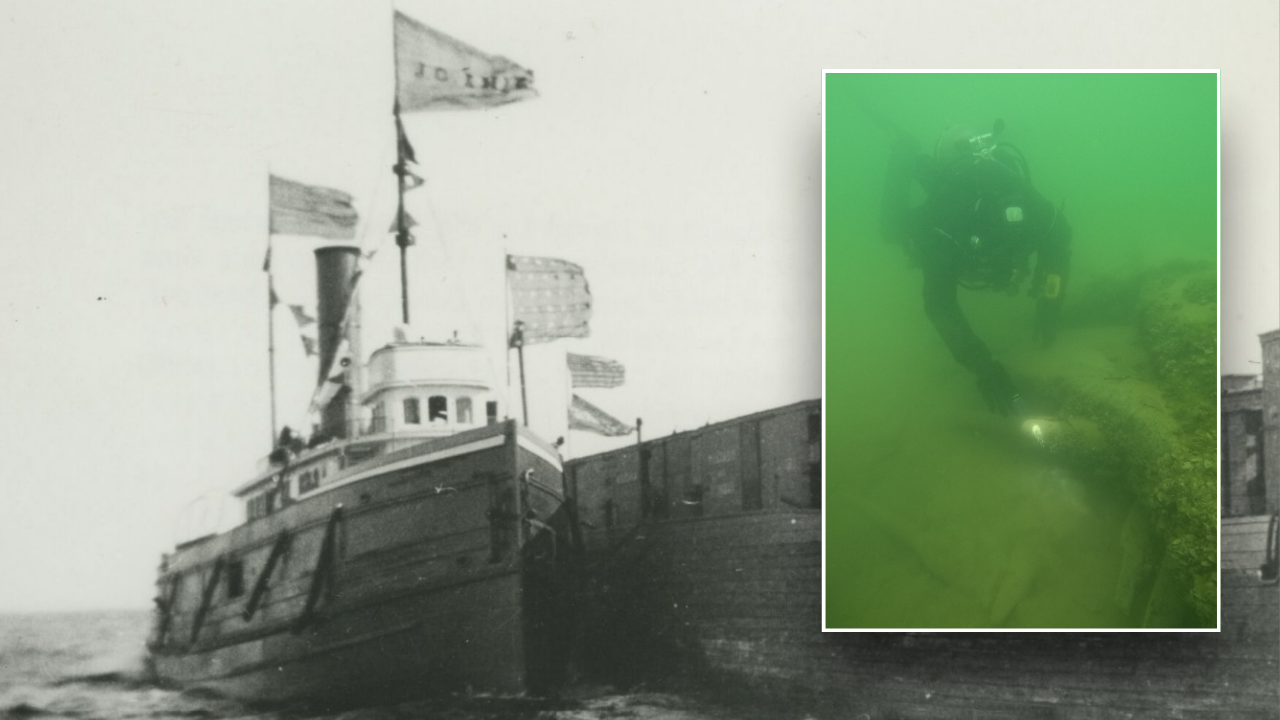What began as an ordinary day on the water for a Wisconsin boating enthusiast turned into an extraordinary discovery that has captured the attention of historians, divers, and maritime enthusiasts across the country. Beneath the calm surface of Lake Michigan, a relic of the past had been resting silently for decades—until a chance encounter brought it back into the spotlight.
The Great Lakes are famous for their abundant maritime legacy. Throughout the years, countless ships have traversed these expansive waters, transporting goods, people, and hopes for affluence. Yet, these very waters that facilitated commerce and movement also hid their own calamities, taking ships during violent tempests and erratic weather. Numerous vessels disappeared without a trace—until today.
An unplanned meeting during a regular trip
The boater, who wishes to remain anonymous for now, set out for a quiet day of fishing on Lake Michigan, one of the five Great Lakes and the only one entirely within the United States. Known for its vast expanse and sometimes treacherous waters, the lake has been both a lifeline and a graveyard for countless ships over the centuries.
On this particular day, weather conditions were ideal—clear skies, calm waters, and a light breeze sweeping across the surface. Using modern sonar equipment to locate schools of fish, the boater noticed something unusual on the display. Instead of the typical formations of fish or natural debris, the image revealed a distinct, elongated shape lying on the lakebed.
Intrigued, the sailor chose to explore more deeply. After accurately pinpointing the spot and deploying a submerged camera, the display started to unveil something remarkable: the outline of an undamaged wooden craft, including masts and additional structural elements, indicating it was an ancient vessel.
A window into maritime history
Experts have long suspected that dozens of shipwrecks remain hidden beneath the waters of Lake Michigan, many of them dating back to the 19th and early 20th centuries when the Great Lakes served as major trade routes. The newly discovered vessel appears to match the characteristics of ships from that era, offering a rare opportunity for researchers to study a remarkably preserved piece of nautical heritage.
Initial assessments suggest that the wreck could be a schooner, a type of sailing vessel widely used during the 1800s for transporting lumber, grain, and other goods. These ships were essential to the economic development of the Midwest, navigating the vast network of lakes and rivers to connect inland communities with major markets.
The frigid freshwater environment of the Great Lakes is known to preserve shipwrecks far better than saltwater conditions, where wood-eating organisms like shipworms typically destroy wooden hulls over time. As a result, many shipwrecks discovered in this region remain astonishingly well-preserved, often with cargo and personal artifacts still intact.
The mystery behind the sinking
While the exact identity of the vessel remains uncertain, maritime historians have already begun compiling a list of candidates based on known shipwreck records. Several schooners were reported lost in the late 1800s during violent storms that struck Lake Michigan without warning. At the time, weather forecasting was rudimentary, and sailors often had little advance notice of approaching gales.
A hypothesis proposes that the recently uncovered vessel might have sunk in one of these notorious tempests. Over the years, the Great Lakes have taken countless lives, developing a reputation as some of the most erratic and perilous inland bodies of water globally. The large expanse of the lake and its changing atmospheric conditions can produce waves comparable to those found in the open sea, challenging even the most seasoned sailors.
Further exploration of the wreck will likely provide vital clues. Researchers hope to find inscriptions, cargo remnants, or personal belongings that can help identify the ship and shed light on the circumstances of its sinking. Every detail recovered will contribute to a broader understanding of the region’s maritime history.
Contemporary tech uncovers concealed gems
This finding highlights the increasing influence of technology in revealing historical artifacts. Several decades ago, finding a shipwreck in the wide expanse of Lake Michigan would have been almost unattainable without years of focused effort. Nowadays, progress in sonar imaging, GPS mapping, and underwater drones has transformed the field of marine archaeology.
The boater’s application of sonar to identify the unusual object shows that even leisure equipment can result in important discoveries. It is anticipated that expert divers and archaeologists will soon perform thorough examinations of the location, using high-definition imaging to chart the wreck and evaluate its status before any physical actions are undertaken.
Preservation is still a major concern. Although the desire to recover artifacts is significant, specialists highlight that interfering with the wreck might lead to permanent harm. The objective, instead, is to record the site comprehensively and, if feasible, classify it as a protected cultural asset according to state and federal laws.
Why shipwrecks matter to our shared history
In addition to their aesthetic allure and enigmatic nature, shipwrecks act as portals to the past, capturing moments of existence from past ages. Each ship narrates a tale—not only of trade and travel, but of those who constructed, voyaged, and occasionally met their end on them. These submerged locations provide unique perspectives on technological progress, trading routes, and cultural interactions of their era.
For communities in the area, these findings hold both emotional and educational significance. Museums throughout the Great Lakes region often showcase displays about shipwrecks, attracting people curious to explore the dangers and achievements of maritime history. This recent discovery is anticipated to generate considerable attention, possibly enhancing cultural tourism and encouraging fresh research endeavors.
Authorities and maritime specialists are currently planning the following procedures, which involve a detailed analysis of the shipwreck’s architecture, material makeup, and its surroundings. The aim is to identify optimal methods for conservation and research without compromising the site’s integrity.
If the vessel can be conclusively identified, it could join the official registry of historic shipwrecks in the Great Lakes. This designation would ensure long-term protection and potentially open opportunities for virtual tours, 3D mapping projects, and educational programs.
As for the boater who stumbled upon the wreck, their unexpected role in this discovery serves as a reminder that history often hides in plain sight—waiting for the right combination of curiosity, technology, and chance to bring it to light.
What lies beneath the waters of Lake Michigan remains a source of wonder, and each new discovery reinforces the profound connection between the past and the present. In the silent depths where time seems frozen, stories of courage, tragedy, and resilience continue to echo, inviting us to explore, learn, and preserve.




